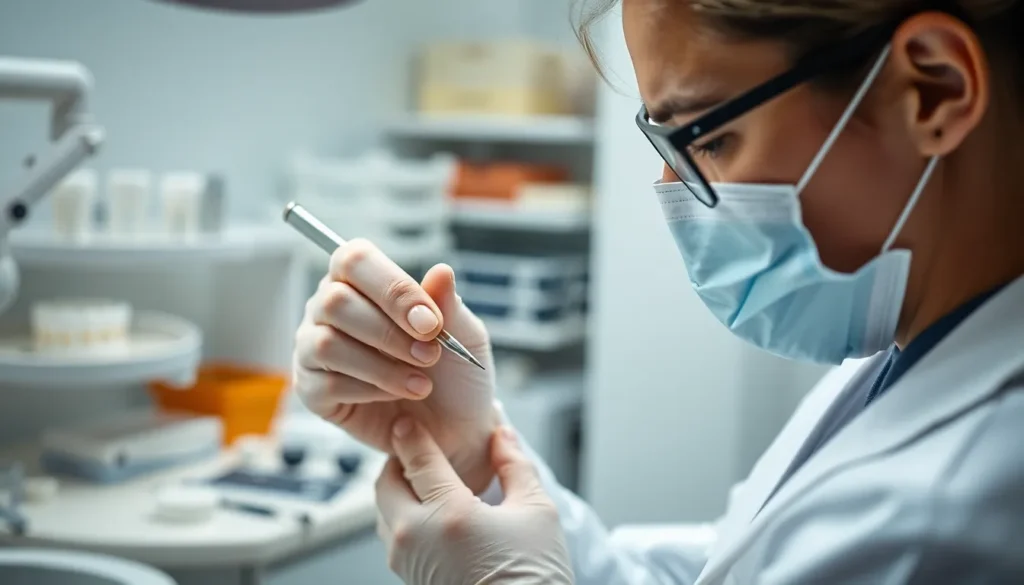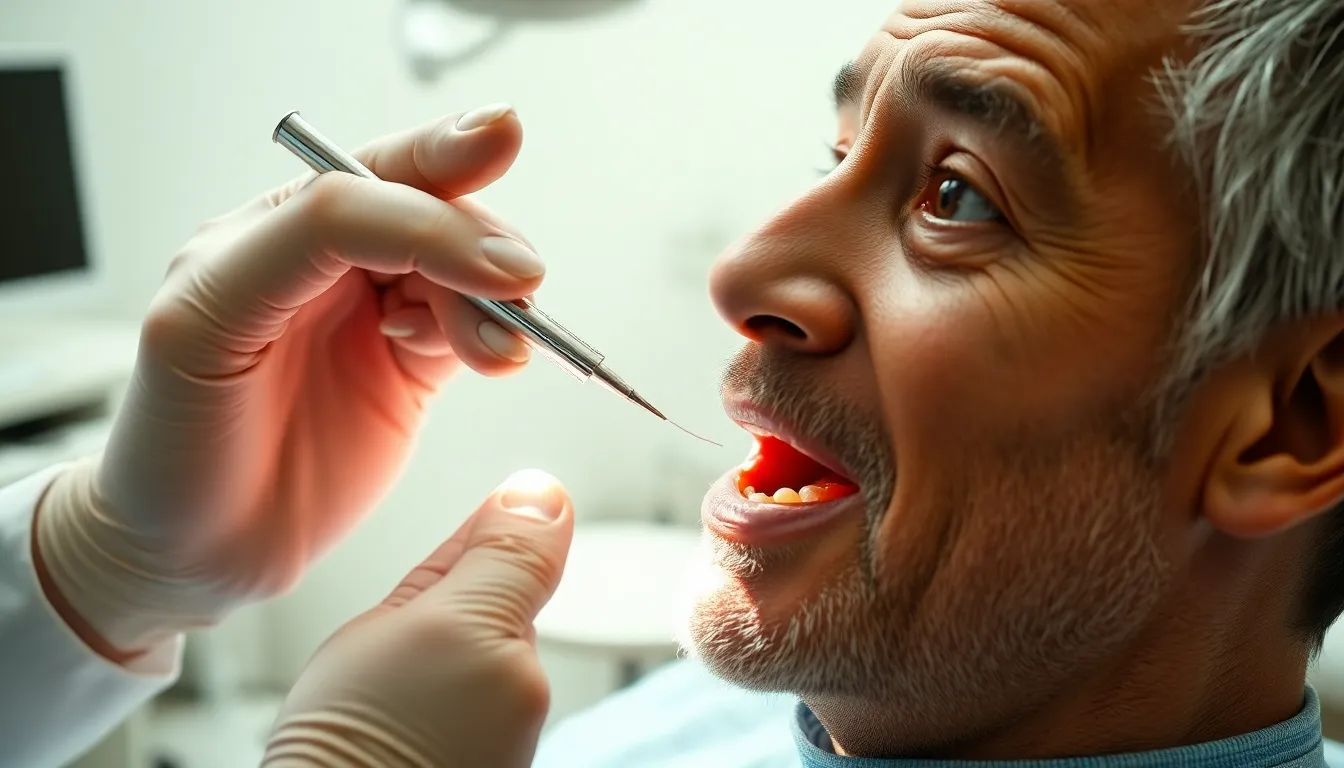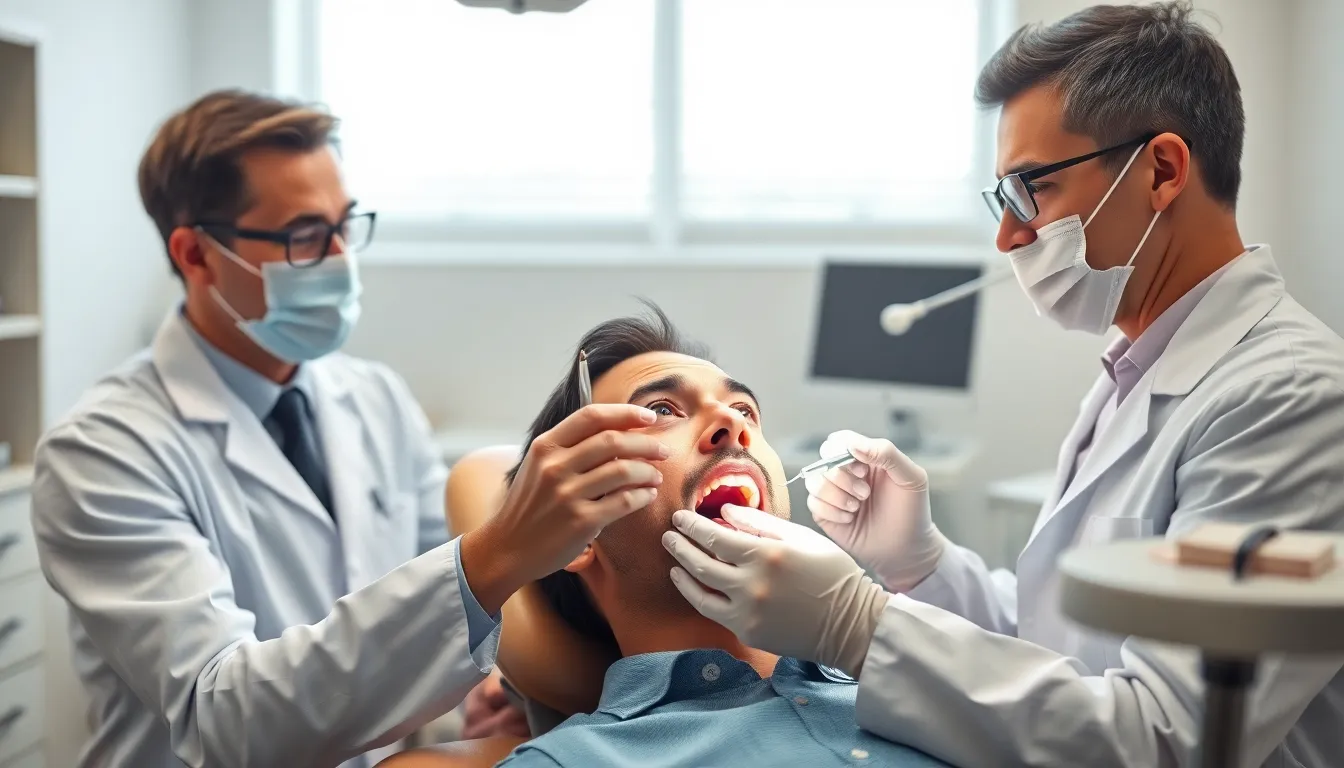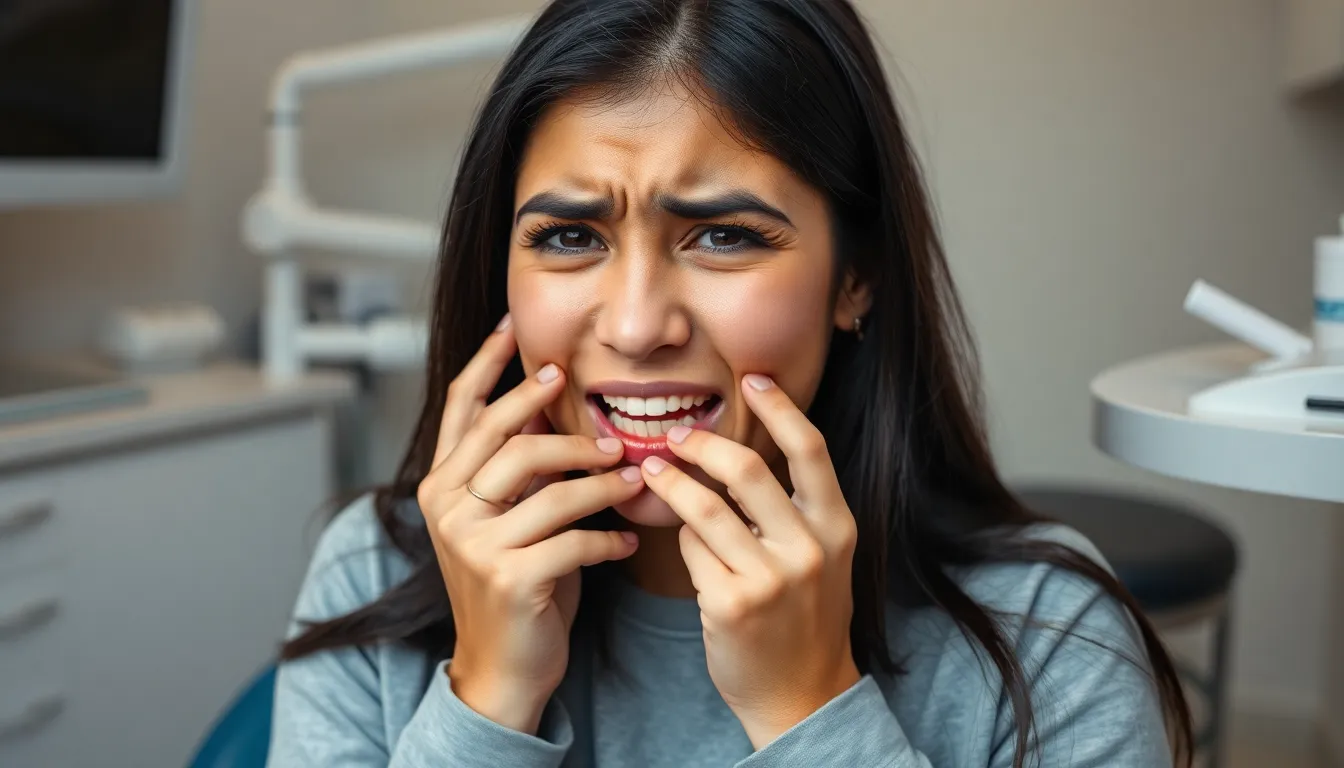Wondering what makes indirect restorations different from other dental procedures? These custom-made dental answers offer a durable, aesthetic way to repair damaged teeth while preserving your natural smile.
When your tooth needs more than a simple filling but doesn’t require a complete crown, indirect restorations provide the perfect middle ground. These laboratory-crafted answers—including inlays, onlays, veneers, and crowns—are designed to fit precisely over your prepared tooth structure. Unlike direct fillings that are molded directly in your mouth, indirect restorations are created from impressions of your teeth, ensuring exceptional fit and longevity. They’re particularly valuable for repairing teeth with extensive damage while maintaining your tooth’s natural appearance and function.
What Is an Indirect Restoration?
Indirect restorations are dental prosthetics created outside your mouth and then permanently bonded to your tooth. Unlike direct fillings that dentists shape directly in your cavity, these custom-made restorations require two or more appointments to complete. The fabrication process involves taking precise impressions of your prepared tooth, which are then sent to a dental laboratory where skilled technicians create the restoration using high-quality materials.
Common types of indirect restorations include inlays, onlays, veneers, and crowns, each serving different purposes based on the extent of tooth damage. Inlays fit within the cusps of your tooth, while onlays extend over one or more cusps. Veneers cover the front surface of teeth to improve appearance, and crowns encase the entire visible portion of a tooth.
“I had a patient last month who came in with a severely cracked molar from biting down on an olive pit,” shares Dr. Todd B. Harris. “A direct filling wouldn’t provide enough structural support, but the tooth had enough healthy structure that a full crown seemed excessive. An onlay was the perfect middle-ground solution, preserving more of her natural tooth while providing the necessary strength and protection.”
The primary advantage of indirect restorations is their superior durability compared to direct fillings. Materials like porcelain, ceramic, and composite resins used in indirect restorations can last 10-15 years with proper care, making them a cost-effective long-term solution for damaged teeth. Also, these materials can be precisely color-matched to your existing teeth, creating a natural-looking restoration that’s virtually indistinguishable from your natural tooth structure.
Types of Indirect Restorations
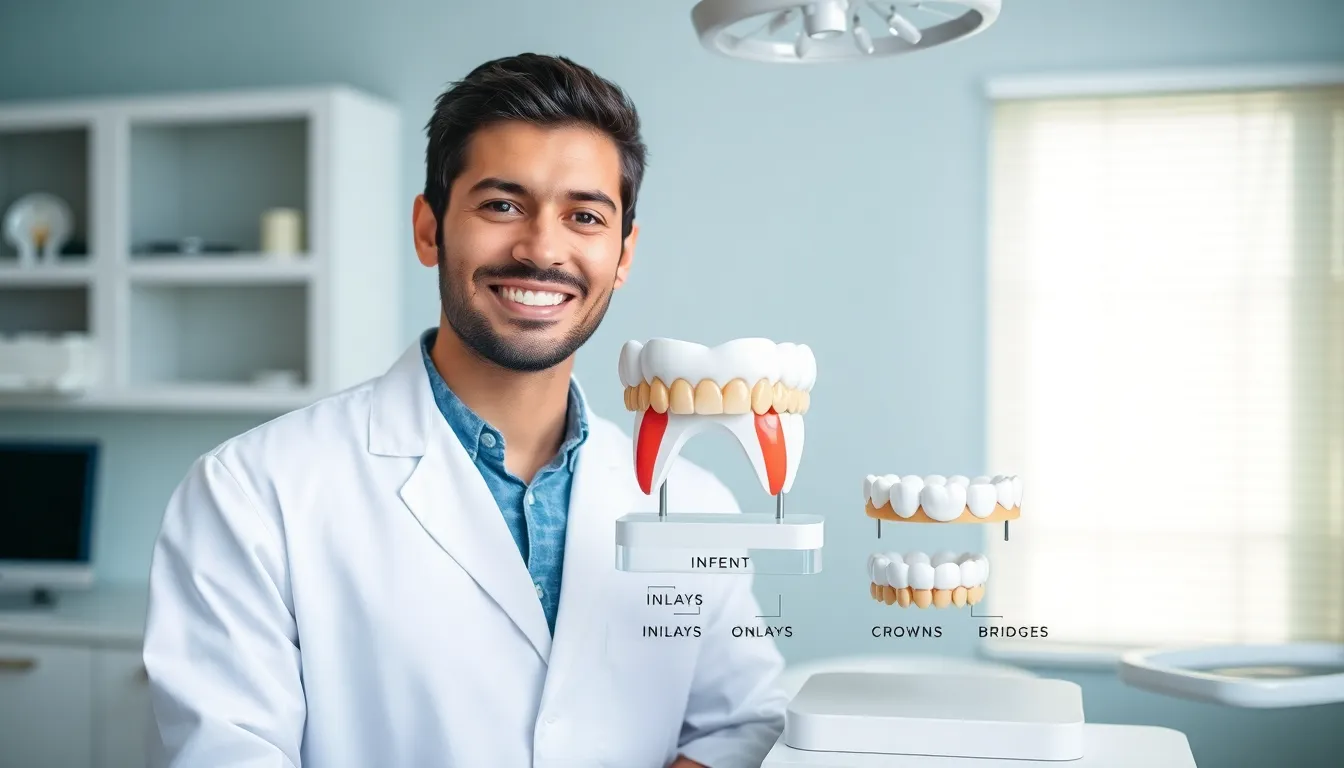
Indirect restorations are custom-made dental answers fabricated outside the mouth in a dental laboratory or using in-office milling equipment. These precision-crafted treatments provide exceptional durability and aesthetics while addressing various levels of tooth damage.
Inlays and Onlays
Inlays offer a precise solution for moderate tooth decay, fitting perfectly within the grooves of your tooth. They’re custom-made to match your natural tooth color while providing a strong, well-sealed restoration that preserves more of your natural tooth structure than a full crown. Dr. Todd B. Harris often recommends inlays for patients with decay limited to the chewing surface that’s too extensive for a simple filling.
Onlays extend beyond what inlays cover, reaching over one or more cusps (the pointed parts) of your tooth. They’re ideal when damage is more important than what an inlay can repair but doesn’t yet warrant a complete crown. A patient of Dr. Harris recently opted for a ceramic onlay after cracking a molar while biting down on an olive pit. The onlay perfectly restored the damaged cusp while maintaining the healthy portions of the tooth, demonstrating the conservative approach these restorations provide.
Crowns
Crowns completely encase the entire visible portion of your tooth above the gum line, restoring its shape, size, strength, and appearance. They’re indicated for teeth with important damage from decay or trauma that can’t be addressed with more conservative treatments. Crowns come in various materials including metal, porcelain, composite, or combinations that balance durability with aesthetics. “Full coverage crowns provide comprehensive protection for heavily damaged teeth,” explains Dr. Harris. “They’re particularly valuable for teeth that have undergone root canal treatment or have large existing fillings that have weakened the remaining tooth structure.”
Bridges
Bridges replace one or more missing teeth by anchoring artificial teeth to adjacent healthy teeth. These restorations span the gap created by missing teeth, with crowns on either end that attach to your natural teeth for support. Bridges restore both function and appearance in areas where teeth have been lost, preventing remaining teeth from shifting position. Dr. Harris recalls a patient who lost two premolars in an accident—after receiving a custom-made bridge, the patient regained full chewing function and confidence in their smile within just two weeks.
Materials Used in Indirect Restorations
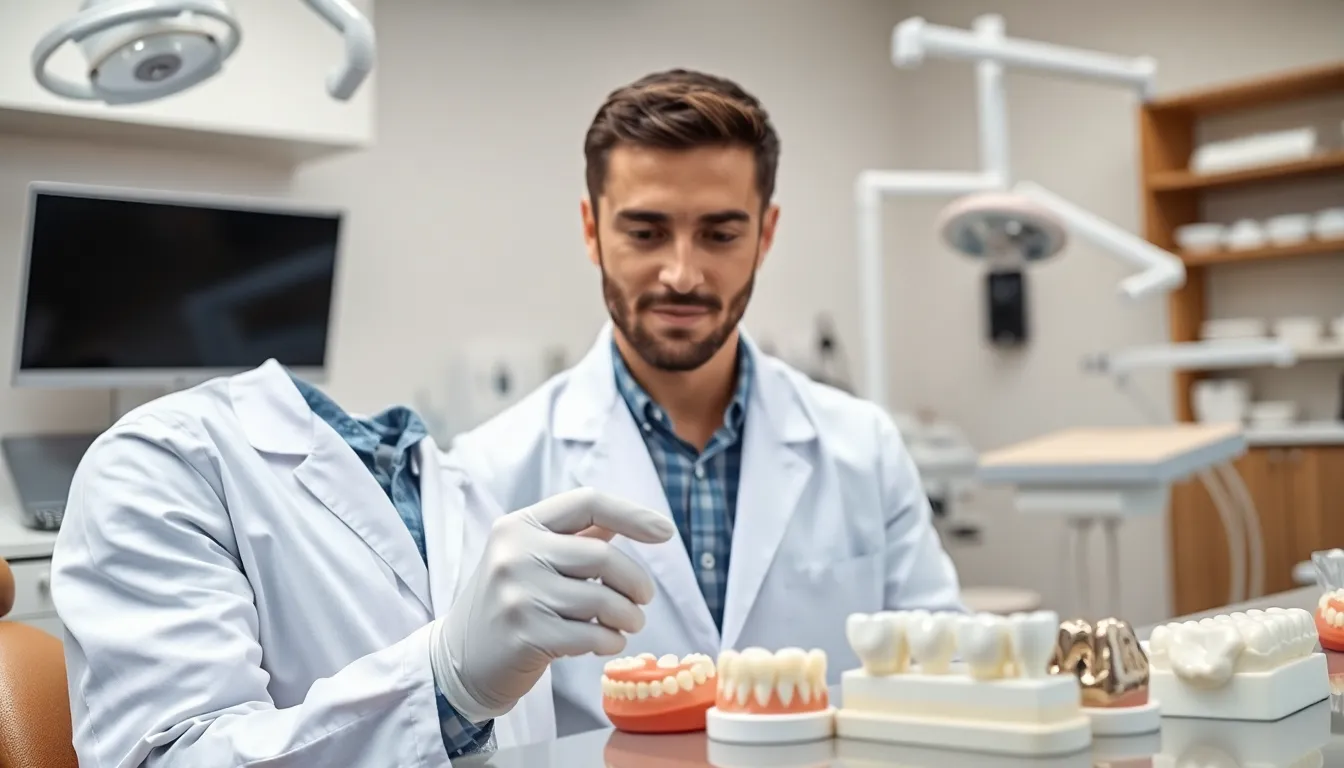
Indirect restorations rely on various materials that provide strength, durability, and aesthetic appeal to damaged teeth. Each material offers unique benefits and is selected based on exact clinical requirements, tooth location, and patient preferences.
Ceramics
Ceramics dominate the indirect restoration industry due to their exceptional aesthetic qualities, biocompatibility, and remarkable durability. Modern dental practices use porcelain and advanced all-ceramic systems including pressed ceramics like Empress and high-strength zirconia for crafting crowns, inlays, onlays, veneers, and bridges. Zirconia has largely replaced traditional metal frameworks because it combines superior strength with natural-looking results. Digital CAD/CAM technology has revolutionized ceramic restoration fabrication by enabling more precise, efficient, and cost-effective production. Dr. Harris often recommends ceramic restorations for front teeth, noting that “patients can’t tell the difference between their ceramic restorations and natural teeth, even years after placement.”
Metals
Gold has long served as the gold standard for indirect restorations, offering unmatched biocompatibility, durability, and adaptability to tooth structures. The prohibitive cost and technique sensitivity of gold have led many dentists to adopt alternatives such as porcelain-fused-to-metal (PFM) restorations, which blend metal strength with ceramic aesthetics. Base metals provide affordable framework options but present challenges in proper adaptation. All-ceramic systems and zirconia have significantly reduced reliance on metal restorations in contemporary dentistry. Many of Dr. Harris’s long-term patients still have gold restorations that have performed flawlessly for decades, particularly in less visible posterior regions.
Composite Resins
Indirect composite resins differ fundamentally from their direct counterparts through external polymerization, allowing for higher filler content and more complete curing. These materials exhibit less polymerization shrinkage and enhanced biocompatibility compared to direct composites. Indirect composites demonstrate greater resistance to degradation and microleakage while providing better flexibility under chewing forces. They’re also gentler on opposing teeth than ceramics. Flexural strength and fracture toughness remain lower than ceramics and metals, limiting their use in high-stress areas. Particle-reinforced composites offer improved properties but haven’t achieved widespread success for crown and bridge applications due to insufficient strength. Dr. Harris typically reserves indirect composites for exact clinical situations where patients seek a balance between aesthetics, durability, and cost.
The Indirect Restoration Process

Indirect restorations involve creating dental prosthetics outside the mouth before permanently placing them in the oral cavity. This multi-step process requires precision at every stage to ensure optimal fit, function, and aesthetics.
Initial Consultation and Preparation
Your journey toward an indirect restoration begins with a comprehensive diagnostic examination. During this appointment, Dr. Harris takes study models from impressions using alginate material to analyze your tooth structure and plan the appropriate restoration. Proper tooth preparation is critical and includes removing any decay or old restoration materials. The tooth is then precisely shaped with exact margins, typically featuring a 90-degree butt-joint cavo surface angle and rounded internal line angles. These techniques minimize stress points and ensure a strong, durable fit. Many of Dr. Harris’s patients appreciate the meticulous preparation process, as one patient noted, “I was amazed at how carefully Dr. Harris prepared my tooth before taking the impression—it made all the difference in how comfortable my final crown feels.”
Impression Taking
Capturing an accurate impression of your prepared tooth is essential for creating a perfectly fitting restoration. The impression quality, particularly around the marginal areas and gingival tissues, directly impacts how well your final restoration will fit. Dr. Harris uses high-quality impression materials that capture even the finest details of your tooth structure. “The impression is like a blueprint for your restoration,” Dr. Harris explains. “Any inaccuracy at this stage can lead to problems with the final fit, which is why we’re extremely particular about our impression techniques.” For patients who prefer cutting-edge technology, digital impressions using CAD/CAM systems offer another precise option that eliminates the need for traditional impression materials.
Laboratory Fabrication
After obtaining your impression, it’s sent to a specialized dental laboratory where skilled technicians fabricate your restoration. This process allows for superior control over shape, fit, and aesthetics compared to direct restorations done entirely in the mouth. Laboratory technicians use your impression to create a model, then carefully create your crown, bridge, inlay, onlay, or veneer using materials like ceramics or composites. They ensure ideal anatomy and perfect proximal contacts for optimal function. Dr. Harris works with a select group of laboratories known for their exceptional craftsmanship. “The relationship between dentist and lab technician is crucial,” Dr. Harris notes. “I’ve partnered with laboratories that understand my standards and consistently deliver restorations that exceed patient expectations.”
Benefits of Indirect Restorations

Indirect restorations offer many advantages that make them an excellent choice for repairing damaged teeth. These custom-made dental answers provide important benefits in terms of strength, appearance, and overall oral health compared to direct restorations.
Durability and Longevity
Indirect restorations deliver exceptional durability that surpasses direct filling options. They withstand higher chewing forces, making them particularly suitable for molars and teeth that experience important stress during daily function. Materials used in these restorations, such as ceramic and porcelain, provide superior strength and remarkable longevity, typically lasting 10-15 years or more with proper maintenance. This extended lifespan often makes indirect restorations more cost-effective over time, as they require fewer repairs or replacements compared to direct alternatives. The robust nature of these restorations also helps reinforce the remaining tooth structure, preventing further damage or fractures, especially in cases where important tooth structure has already been lost.
Aesthetics and Natural Appearance
Indirect restorations create beautifully natural-looking results that blend seamlessly with your existing teeth. Custom fabrication allows for precise matching of color, shape, and translucency to your natural teeth, creating a restoration that’s virtually indistinguishable from surrounding dentition. Materials like porcelain and ceramic mimic natural tooth enamel exceptionally well, reflecting light similarly to natural teeth and maintaining their color over time. This aesthetic advantage makes indirect restorations particularly valuable for visible teeth, improving your smile’s overall appearance. The smooth, polished surfaces of these restorations not only look natural but also resist staining better than some alternative materials, helping maintain their aesthetic appeal for years.
Additional benefits include improved oral hygiene due to the smooth, precisely fitted surfaces that are easier to keep clean. The preservation of tooth structure is another advantage, as less removal of natural tooth material is necessary due to the precision fit of custom-made restorations. Indirect restorations also provide better functionality and stability by restoring larger damaged areas with superior strength, maintaining your natural bite and chewing efficiency. The materials used generally exhibit excellent biocompatibility, reducing risks of allergic or adverse reactions that might occur with other dental materials.
Potential Complications and Limitations
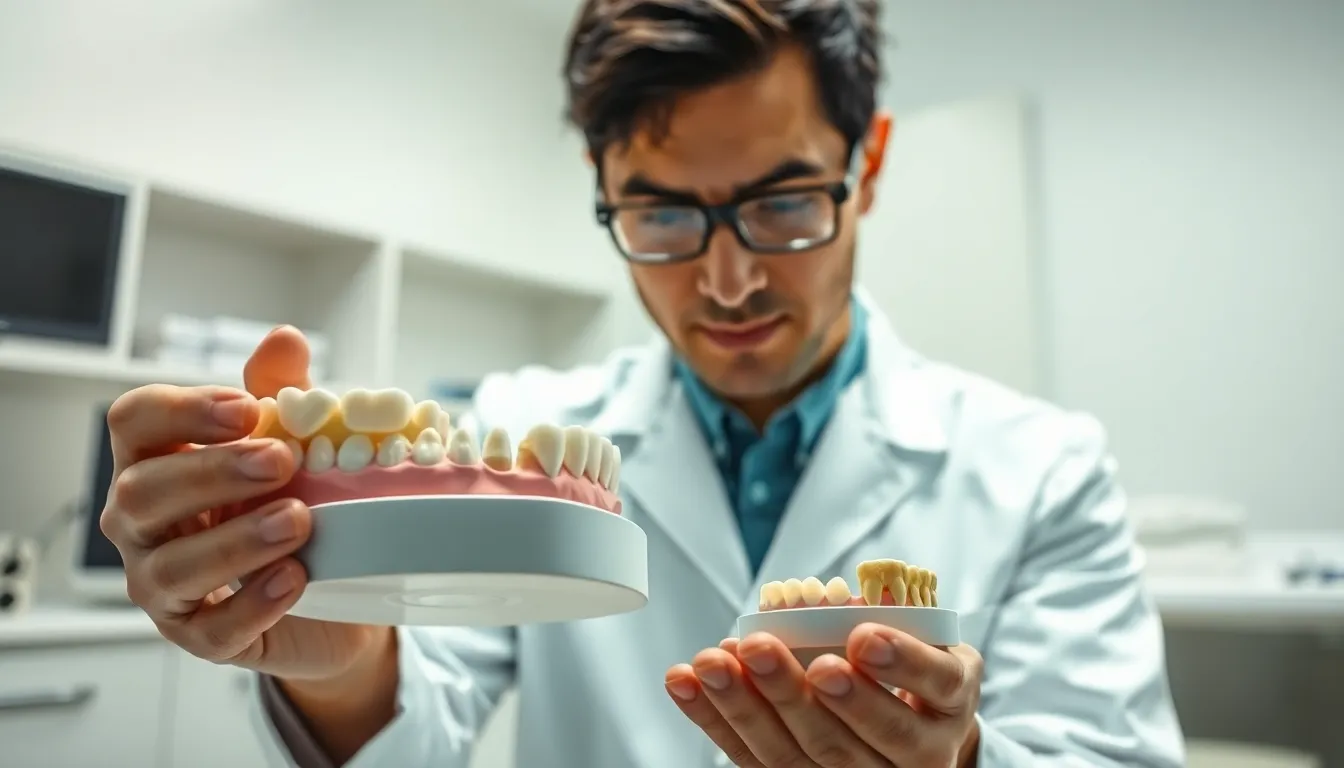
Indirect restorations, while valuable in dentistry, come with several notable complications that affect their long-term success. The average lifespan of these restorations is approximately 10 years before they require complete replacement or lead to tooth extraction. Secondary caries represents a important concern, accounting for about 33% of all indirect restoration failures. Material-exact issues also arise, particularly with zirconia-based restorations which experience chipping and fracture at rates of around 1.09% within five years.
“I’ve seen many patients who expected their indirect restorations to last a lifetime,” notes Dr. Todd B. Harris. “Managing expectations about longevity is crucial to patient satisfaction. I always explain that while these restorations are durable, they’re not permanent answers.”
Limited Longevity
The lifespan of indirect restorations presents a primary concern for both dentists and patients. Most indirect restorations last about a decade before requiring intervention, with many factors influencing their durability. Chewing forces, oral hygiene practices, and parafunctional habits like grinding can significantly reduce restoration longevity. Regular maintenance appointments help identify early signs of wear or failure, potentially extending the useful life of these restorations.
Risk of Secondary Caries
Secondary caries develops at the margins between the restoration and natural tooth structure, representing one-third of all indirect restoration failures. Microscopic gaps can form at these junction points, creating ideal environments for bacteria to colonize. Detection of secondary caries often occurs only after important damage has already happened. Proper oral hygiene techniques, including flossing around restoration margins, are essential to minimize this risk.
Material Complications
Each restorative material carries exact vulnerabilities that affect long-term outcomes. Zirconia restorations, though strong, experience fracture rates of 1.09% within five years. Porcelain materials can chip or crack under heavy forces, particularly in patients with bruxism. Metal-based restorations sometimes cause gingival discoloration or allergic responses in sensitive individuals. The choice of material must balance aesthetic requirements, functional demands, and individual patient factors.
Iatrogenic Damage
The preparation process for indirect restorations carries inherent risks of damage to the tooth and surrounding tissues. Excessive tooth reduction can lead to pulp exposure or thermal sensitivity. Aggressive preparation techniques might damage adjacent teeth or gingival tissues. Temporary restorations sometimes fail during the fabrication period, leading to tooth movement or sensitivity. Patients should understand these potential complications before agreeing to treatment.
“A case that stands out in my practice involved a patient who needed extensive crown work,” shares Dr. Harris. “Even though careful preparation, one tooth developed pulpal inflammation requiring root canal therapy. This reminds us that every invasive procedure carries risks, even when performed with the utmost care.”
Decreased Clinical Indications
The rise of minimally invasive direct restorative techniques has narrowed the indications for indirect restorations in modern dentistry. Advancements in adhesive technologies and direct composite materials now allow successful restoration of teeth that previously required indirect approaches. Conservative treatments preserve more natural tooth structure and often come with lower costs for patients. The shift toward minimally invasive dentistry continues to reshape treatment planning decisions.
Procedural Complexity
The multi-step nature of indirect restorations introduces many opportunities for error. Success depends on meticulous execution at every stage—from initial assessment through final cementation. Impression inaccuracies lead to poor-fitting restorations and subsequent failures. Laboratory communication issues result in aesthetic or functional shortcomings. Temporary restoration problems cause patient discomfort between appointments. These complexities demand exceptional attention to detail throughout the treatment process.
Caring for Your Indirect Restoration
Proper maintenance extends the life of your indirect restoration while preserving its appearance and function. Daily brushing twice and flossing once removes plaque from restoration margins, preventing decay and gum disease. Hard candies, ice, and sticky foods like caramel pose risks to your restoration’s integrity, potentially causing cracks or dislodgement.
Regular dental check-ups allow for professional evaluation of your restoration’s condition. Dr. Todd B. Harris recommends scheduling appointments every six months, explaining, “I’ve seen patients extend their restorations’ lifespan by years simply through consistent professional monitoring and cleaning.”
Unexpected symptoms like pain, sensitivity, or looseness require immediate attention. A restoration that feels loose might indicate cement failure, while persistent discomfort could signal underlying issues requiring professional assessment.
Many patients benefit from wearing a custom night guard, especially those with bruxism. A patient of Dr. Harris shared, “After getting my ceramic onlays, Dr. Harris noticed slight wear patterns indicating nighttime grinding. The night guard he recommended has protected my investment for over eight years now.”
Specialized cleaning tools enhance your home care routine. Interdental brushes clean hard-to-reach areas around bridges, while water flossers effectively remove debris from restoration margins. Antimicrobial mouth rinses provide additional protection against bacteria accumulation around indirect restorations.
| Care Recommendation | Benefit | Frequency |
|---|---|---|
| Brushing with non-abrasive toothpaste | Prevents surface scratching | Twice daily |
| Flossing around restoration margins | Removes trapped food particles | Daily |
| Professional dental cleaning | Removes tartar buildup | Every 6 months |
| Night guard use (if recommended) | Prevents grinding damage | Nightly |
| Avoiding hard/sticky foods | Prevents fractures and dislodgement | Continuous |
Cost Considerations and Insurance Coverage
The Investment in Indirect Restorations
Indirect restorations represent a important dental investment compared to direct alternatives. Laboratory fabrication increases costs due to the specialized materials and skilled technician labor required to create these custom prosthetics. Each restoration is meticulously crafted outside the mouth, resulting in a more precise fit and superior durability but at a higher price point.
Dr. Todd B. Harris explains, “When discussing treatment options with my patients, I’m transparent about the initial cost difference between indirect and direct restorations. Many patients find that the longevity and reduced need for replacements make indirect restorations more economical over time even though the higher upfront expense.”
Factors Affecting Pricing
Several elements influence the cost of your indirect restoration:
- Material selection impacts pricing significantly, with advanced ceramics like zirconia typically commanding premium prices
- Extent of tooth damage determines the complexity of preparation and type of restoration needed
- Geographic location affects pricing based on regional market rates and cost of living
- Dental laboratory quality varies, with high-end labs charging more for their expertise
- Tooth position matters, as restorations for visible front teeth often require more aesthetic consideration
Insurance Coverage Breakdown
Insurance coverage for indirect restorations varies considerably between providers and plans. Most dental insurance policies provide partial coverage for these procedures when deemed medically necessary rather than purely cosmetic.
Typical coverage patterns include:
| Restoration Type | Average Insurance Coverage | Patient Responsibility |
|---|---|---|
| Inlays/Onlays | 50-80% after deductible | 20-50% plus deductible |
| Crowns | 50% after deductible | 50% plus deductible |
| Veneers | 0-50% (if medically needed) | 50-100% |
| Bridges | 50% after deductible | 50% plus deductible |
Insurance companies typically recognize exact dental codes for indirect restorations, such as D2792 for a full cast noble metal crown, which helps determine coverage eligibility. Most plans include related procedures like impressions, temporary restorations, and final cementation in the overall covered cost.
“I’ve seen patients hesitate about proceeding with indirect restorations due to cost concerns,” shares Dr. Harris. “One particular patient postponed getting a needed crown for months until experiencing severe pain. After finally proceeding with treatment and discovering her insurance covered more than expected, she expressed regret at not addressing it sooner. That’s why we always provide detailed pre-treatment estimates to help patients understand their financial responsibility.”
Maximizing Your Benefits
To optimize your insurance benefits for indirect restorations:
- Request a pre-treatment estimate from your dentist before proceeding
- Check if your plan has waiting periods for major restorative work
- Understand your annual maximum and plan accordingly if multiple restorations are needed
- Ask about flexible spending accounts or health savings accounts to cover out-of-pocket costs
- Inquire about payment plans or third-party financing options for portions not covered by insurance
Many dental practices offer payment options to make indirect restorations more accessible, spreading the cost over several months rather than requiring full payment upfront.
Conclusion
Indirect restorations represent a important advancement in modern dentistry offering you both functional and aesthetic benefits that extend well beyond traditional fillings. When properly maintained with regular brushing flossing and dental check-ups these custom-crafted answers can serve you reliably for over a decade.
Though they require a higher initial investment and multiple appointments the long-term value becomes evident through their superior durability precision fit and natural appearance. Your commitment to proper care will maximize their lifespan.
Whether you need an inlay onlay veneer crown or bridge the right indirect restoration can effectively repair damaged teeth while preserving your natural smile. Discuss material options insurance coverage and maintenance requirements with your dentist to determine if an indirect restoration is the optimal solution for your exact dental needs.
Frequently Asked Questions
What are indirect dental restorations?
Indirect dental restorations are custom-made prosthetics created outside the mouth and then permanently bonded to the tooth. They include inlays, onlays, veneers, crowns, and bridges, and are ideal when a simple filling isn’t sufficient but a full crown may not be necessary. Unlike direct fillings, these restorations require at least two appointments to complete.
How long do indirect restorations last?
Indirect restorations typically last 10-15 years or more, significantly outlasting direct fillings. Their durability depends on the material used, your oral hygiene practices, and whether you avoid habits that could damage them. With proper care and regular dental check-ups, some patients enjoy their restorations for 20+ years.
What materials are used for indirect restorations?
The primary materials include ceramics (porcelain and zirconia), metals (gold and PFM), and indirect composite resins. Ceramics are favored for their exceptional aesthetics and biocompatibility. Zirconia has largely replaced traditional metal frameworks due to its strength and natural appearance. Material selection depends on clinical requirements and patient preferences.
How are indirect restorations made?
The process begins with a consultation and diagnostic examination, followed by tooth preparation to remove decay. The dentist takes precise impressions (traditional or digital) that serve as blueprints for the restoration. These impressions are sent to a dental laboratory where skilled technicians fabricate the custom restoration, ensuring optimal shape, fit, and aesthetics.
What are the benefits of choosing indirect restorations?
Indirect restorations offer exceptional durability, withstanding higher chewing forces than direct fillings. They provide superior aesthetics, as they’re custom-made to match your natural teeth. Their precise fit preserves more tooth structure, improves oral hygiene with smooth surfaces, and maintains natural bite function. They’re also highly biocompatible with surrounding tissues.
What complications can occur with indirect restorations?
Potential complications include secondary caries (accounting for 33% of failures), material-specific issues like chipping in zirconia restorations, and procedural errors during fabrication. Their average lifespan is about 10 years, though this varies widely. Modern direct restorative techniques have also narrowed the indications for these more complex treatments.
How should I care for my indirect restoration?
Maintain excellent oral hygiene with daily brushing and flossing. Avoid hard and sticky foods that could damage the restoration. Attend regular dental check-ups every six months. Use a custom night guard if you grind your teeth. Seek immediate attention if you experience pain or looseness. Using specialized cleaning tools can enhance your home care routine.
How much do indirect restorations cost and does insurance cover them?
Costs vary widely based on material, extent of damage, geographic location, laboratory quality, and tooth position. While more expensive initially due to laboratory fabrication and specialized materials, their longevity often makes them economical long-term. Insurance coverage varies by provider and plan, with most covering 50-80% of crowns and bridges but less for cosmetic procedures like veneers.

